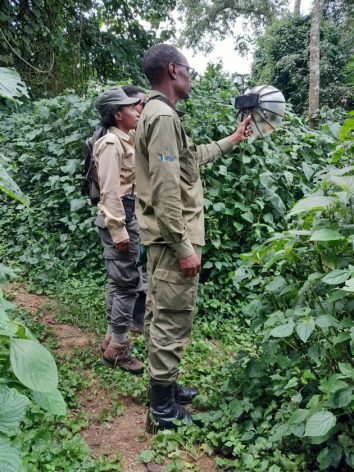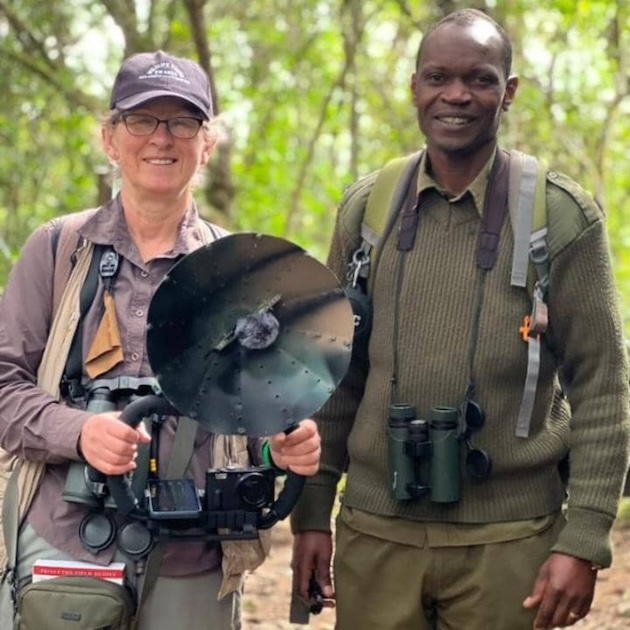By Aimable Twahirwa
Claver Ntoyinkima wakes up early in the morning, at least three times a week, and goes into the Nyungwe rainforest to record bird vocalizations.
Ntoyinkima is one of several community members in a remote village in rural southwestern Rwanda who volunteer with a group of scientists to help boost wildlife conservation in Nyamasheke district.
Relying on a voice application installed on his mobile phone, which is connected to a parabolic reflector with a dedicated cable, the 50-year-old tour guide and his team walk long distances every week to collect sounds from various birding hotspots in this area.
“Love for birds is critical when it comes to engaging many young people in this career,” Ntoyinkima told IPS while referring to his second profession of bird sound recording.
To better protect the birds, the veteran tour guide has been able to launch the Nyungwe Birding Club, bringing together about 86 members of local communities living in Gisakura, a remote village located on the outskirts of the Nyungwe rainforest in southwestern Rwanda. Thanks to this mobilization, members of the club, which also consists of 26 young students from primary and secondary schools, were equipped with skills on how to record bird sounds.
The initiative is part of joint efforts by the Planet Birdsong Foundation, an international UK-based charity organization, and the Center of Excellence in Biodiversity and Natural Resource Management at University of Rwanda seeking to connect people with nature through bird sound listening, recording, and audio processing.

Conservation experts believe that birds are important indicators for the biodiversity and health of a habitat where they are sometimes visible but more widely audible. Researchers are now convinced that audio recognition skills are vital for effective monitoring and guiding, especially in forests and wetlands.
“We are engaging youth from rural communities through local bird clubs, site guides, schools, and colleges,” Hilary MacBean, trustee of the Foundation, told IPS.
It is a major task to collect mass data covering the sounds of various species across various birding hotspots in this East African country.
Nyungwe natural reserve is known to be home to 278 species of birds—26 of those are found only in the few forests of the Albertine Rift. The latest scientific estimates show that there are seven other important birding areas in Rwanda, including three wetland areas at Akanyaru (south), Nyabarongo river system (south), and Rugezi swamp (north), where there are efforts to recover the biodiversity from human activities that led to the degradation of these hotspots. The urban wetland in Kigali city has also received massive investment and is radically improving.
“This task requires much practice for people so that they are able to decode all those different bird songs and calls,” Ntoyinkima said.
At present, the first ever Rwandan citizen science initiative, which has been running since 2021, focuses on equipping young students, many from rural communities, with the skills to observe, audio record, and scientifically label birds by their sounds, songs, and calls.
By using affordable sound recording equipment aimed at entry-level citizen scientists, participants are trained in audio-data collection, verification, preparation, and storage for both higher-level scientists and other citizen scientists. Currently, different existing teams deployed across birding hotspots in Rwanda are divided into categories, including recordists and verifiers.
Experts also point out that using the available dataset with multiple records of the songs and calls of the bird population has been crucial to ensuring the protection of species that are forest-dependent.
Through the “Bioacoustics Recording” initiative, which the foundation and other stakeholders jointly run, MacBean has been involved in mentoring and training young bird guides from Rwanda for international tourism while also educating local guides and students about bird sounds.
“Key focus has been on equipping communities with skills on how to work with bioacoustics data collected in the field as a means to identify bird species in the recordings with confidence,” she said in an exclusive interview.

Hilary MacBean of the Planet Birdsong Foundation has been involved in mentoring and training Rwandan young bird guides for international tourism while bringing awareness and knowledge of bird sounds to local guides and students. Credit: Planet Birdsong Foundation
During the implementation phase, data collection is done by using a smart phone with downloadable free apps and a ParaChirp, an acoustic parabolic reflector designed for educational use to promote learning about birds and product design. The technology focuses mainly on individual bird songs and calls collected in their natural or semi-natural habitat.
The latest official estimates by the Rwanda Environment Management Authority (REMA) show that Rwanda boasts more than 703 bird species, making it one of the countries with the highest concentration of bird populations in Africa.
However, Protais Niyigaba, the Nyungwe Forest National Park’s manager, told IPS that much effort has been put into providing migratory birds with safe habitats and breeding sites.
“These solutions with available recording data are currently helping to understand the routes of these migratory birds and make sure visitors are able to locate them easily by sound,” Niyigaba said.
The project had uploaded 226 recordings as of the time of the Foundation’s 2023 audit report, with 37 of those being in national parks. The number of recordings is constantly growing, with multiple records of the songs and calls of about 120 bird species across Rwanda.
By December 2024, the Foundation has set a goal of generating 275 recordings, including 75 bird sounds, from existing national parks across Rwanda. The target set for 2025 is 300 species, according to official projections.
“We create music from bird sound and, in the Rwandan context, focus on the community benefits of citizen science, bird sound collection for scientific monitoring, and building the identification skills of tourist guides,” MacBean said.
With this integration of bird sound recordings to protect and preserve these species and their habitats, stakeholders focus on labeling the collected data so that their identification, locational and time data, behavioral data, and habitat data are all recorded. The sounds are then validated by assigned verifiers, processed, and stored for use in science.
Recordings generated by Planet Birdsong’s citizen scientists are stored globally with e-bird, and researchers are collaborating with the Macaulay Library at Cornell University to ensure access to locally recorded bird sounds for both citizen scientists and specialists.
For the specific case of Rwanda, data collected in Rwanda is also supplied to the Rwanda Biodiversity Information System developed by the Centre of Excellence in Biodiversity and Natural Resource Management at University of Rwanda for use in local natural science. Yet these innovations are playing pivotal roles in Rwanda’s bird protection, and some researchers believe that maintaining data availability is essential for effective bird biodiversity conservation.
Professor Beth Kaplin, a prominent conservation scientist based in Rwanda, told IPS that getting local researchers, students, and youth involved in data collection and management is important to developing a sense of ownership and stewardship of the data recording for bird sounds.
Despite current efforts, conservation experts point out that limited funding to support people and pay their fieldwork expenses is another major challenge affecting project implementation since the majority of local residents work mainly on a volunteer basis. Some individuals engaged in the project also have problems with equipment such as phones and PCs, plus the cost of the internet.
Dr Marie Laure Rurangwa, a Rwandan female conservation scientist, told IPS that one of the challenges facing people engaged in this activity is much about processing time with much editing [of recordings] and the skillsets needed in terms of sound recognition for different bird species.
Rurangwa is a co-author of the latest peer review study showing how land use change (modification from primary forest to other land use types) has affected bird communities within Nyungwe forest in Rwanda
“Access to some of these remote birding hotspots has been another challenge for recordists because of limited resources and a lack of appropriate equipment to reach these remote areas,” Rurangwa points out.
But in Gisakura, a remote village nestled on the outskirts of Nyungwe Forest, Ntoyinkima and his team are trying to use affordable means in their field recording by splitting into small groups of five people each.
Before their deployment to various sites inside and outside the forest, each group has to travel several kilometers to reach the selected birding hotspots.
As they walk quietly along a narrow trail and water flows beneath their feet, the team has to stop sometimes to better identify birds through their vocalizations.
Yet most trained people are able to capture data and generate robust, sound recognition results. Expert verifiers are sometimes asked to provide support when some recordists are stuck for identification or to confirm when in doubt.
“These young people are still volunteering here, but in most cases, the majority of them end up being hired as tour guides because they are well trained in bird vocalizations,” Ntoyinkima said.
Credit: IPS
